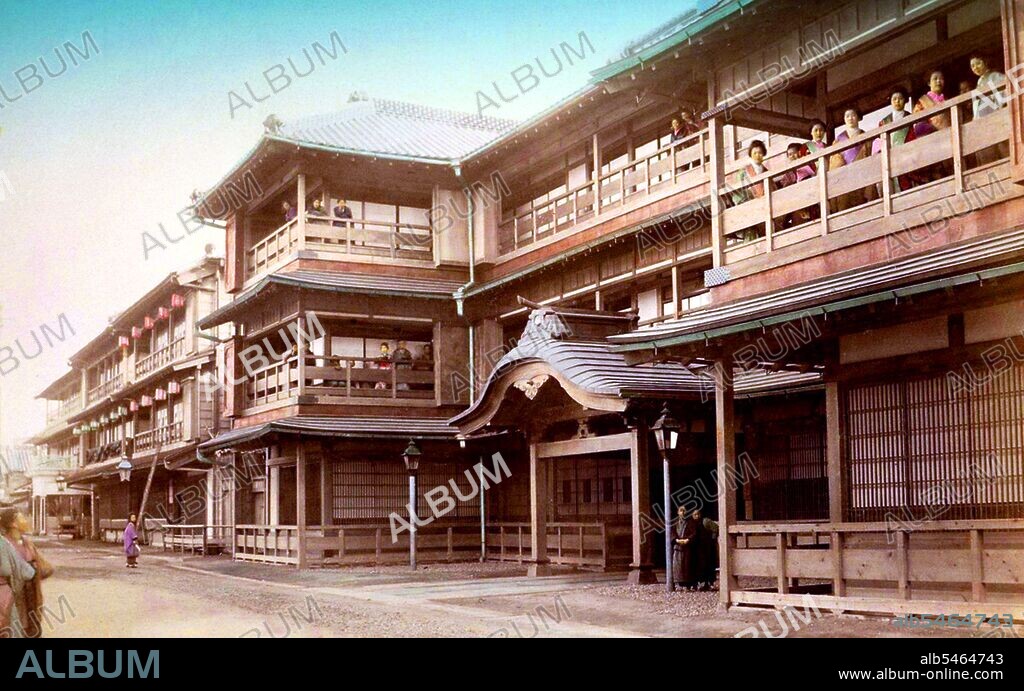alb5464743
Japan: Prostitutes line a balcony in the Yoshiwara red Light District, Tokyo, c. 1895

|
Add to another lightbox |
|
Add to another lightbox |



Title:
Japan: Prostitutes line a balcony in the Yoshiwara red Light District, Tokyo, c. 1895
Caption:
Yoshiwara (??) was a famous Akasen district (red-light district) in Edo, present-day Tokyo, Japan. In the early 17th century, there was widespread male and female prostitution throughout the cities of Kyoto, Edo, and Osaka. To counter this, an order of Tokugawa Hidetada of the Tokugawa shogunate restricted prostitution to designated city districts. These districts were Shimabara for Kyoto (1640), Shinmachi for Osaka (1624–1644) and Yoshiwara for Edo (1617). The main reason for establishing these nightless cities was the Tokugawa shogunate's trying to prevent the nouveau riche chonin (townsmen) from political intrigue. People involved in mizu shobai (????) 'water trade' would include hokan (comedians), kabuki (popular theatre of the time), dancers, dandies, rakes, tea-shop girls, Kano (painters of the official school of painting), courtesans who resided in seiro (green houses) and geisha in their okiya houses. The courtesans would consist of yujo (women of pleasure/prostitutes), kamuro (young female students), shinzo (senior female students), hashi-joro (lower-ranking courtesans), koshi-joro (high-ranking courtesans just below tayu), tayu (high-ranking courtesans), oiran ('castle-topplers', named that way for how quickly they could part a daimyo (lord) from his money), yarite (older chaperones for an oiran), and the yobidashi who replaced the tayu when they were priced out of the market. In addition to courtesans, there were also geisha/geiko, maiko (apprentice geishas), otoko geisha (male geishas), danna (patrons of a geisha), and okasan (geisha teahouse managers). The lines between geisha and courtesans were sharply drawn, however - a geisha was never to be sexually involved with a customer, though there were exceptions.
Credit:
Album / Pictures From History/Universal Images Group
Releases:
Model: No - Property: No
Rights questions?
Rights questions?
Image size:
5100 x 3179 px | 46.4 MB
Print size:
43.2 x 26.9 cm | 17.0 x 10.6 in (300 dpi)
Keywords:
ASIA IMAGE • ASIA PICTURES • ASIA • ASIAN IMAGES • ASIAN PICTURES • ASIAN • COURTESAN • FASHION • FLOATING WORLD • HISTORIA UNIVERSAL • HISTORICAL IMAGES • HISTORICAL PICTURES • HISTORICAL • HISTORY IMAGES • HISTORY PICTURES • HISTORY • HUMAN SEXUALITY • JAPAN • JAPANESE • KIMONO • MODA • OBJECTS OF DESIRE • OIRAN • PROSTITUTE • PROSTITUTES • PROSTITUTION • SEX TRADE • SEX • STYLE • TAYU • WATER BUSINESS • WOMAN • WOMEN • YOSHIWARA
 Pinterest
Pinterest Twitter
Twitter Facebook
Facebook Copy link
Copy link Email
Email

